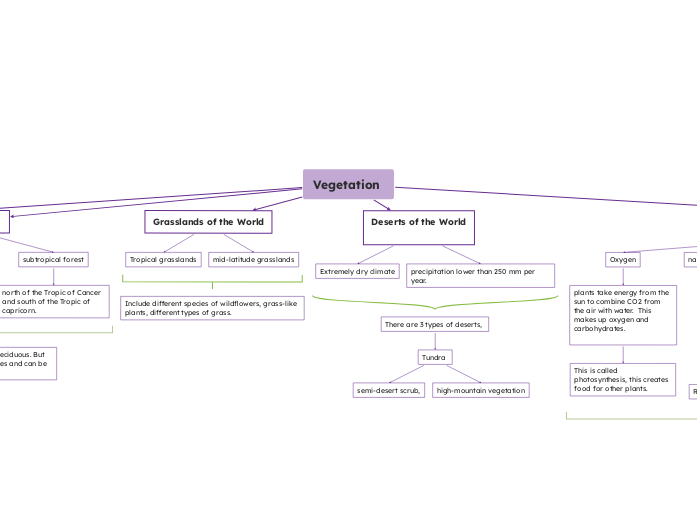Vegetation
Earth’s Natural Vegetation Regions
Forests
Grasslands
deserts
Forests of the world
Boreal forest
northern regions
tropical forest
between tropic of capricorn and tropic of cancer
subtropical forest
north of the Tropic of Cancer and south of the Tropic of capricorn.
Grasslands of the World
Tropical grasslands
mid-latitude grasslands
Deserts of the World
Extremely dry climate
precipitation lower than 250 mm per year.
Benefits of vegetation
Oxygen
plants take energy from the sun to combine CO2 from the air with water. This makes up oxygen and carbohydrates.
This is called photosynthesis, this creates food for other plants.
natural habitats
food
shelter
water
Reproduction
recreation
Human usages and interests
camping in forests
hiking
skiing
swimming in natural waters
resources
materials from plants
cotton
woods
vines
medicinal plants
spiritual connection
Is very important to the aboriginals and their culture
plants for
medicine and for ceremonial
purposes.
sweetgrass, sage, and
cedar are very important to the first nations here in north america.
Materials made from plants has provided us humans all sorts of purposes since the start of human evolution. From warmth, consumption, shelter, weapons, and even to medicinal purposes.
All these benefits of vegetation are crucial and important for our health and well-being. So we must keep caring and appreciate this land and it's vegetation.
These are all hobbies and activities that entertain and keep you healthy, and these activities can take place in nature.
Include different species of wildflowers, grass-like plants, different types of grass.
Some trees can be coniferous and deciduous. But Broadleaf trees have wide, flat leaves and can be both coniferous and deciduous.
There are 3 types of deserts,
Tundra
semi-desert scrub,
high-mountain vegetation
These are the three major vegetation regions on earth, These regions all each claim 1/3 of the earth's total amount of land.
